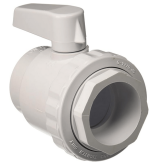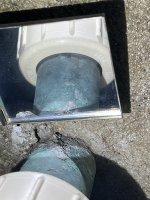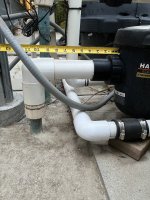Do I need to install a valve to prevent water flowing back to the pool whenever I open the pump basket, or is a valve not necessary?
The instructions for the pump say to never run the pump without water:

Here is a thumbnail picture of my pump inlet with a ruler:

Whenever I try to clean my pump basket, the pump drains back toward the pool skimmer, or at least straight down to a pool level (if assuming the horizontal pipe running to the pool is all below pool level). I can't prime the pump with a bucket of water, because the water just immediately drains out, so when priming it sucks air for some time before it gets any water. I did finally install a Hayward manual 3-way diverter valve between the pump and the filter, so at least I can block the filter from draining. The pump was installed at an unknown time by the previous house owner (we bought the house in Sept 2021), so the pump has been run this way for years. Hope it is not damaged.
A few facts (not sure if any of these are important besides the length of inlet pipe before the pump):
-pump inlet is higher than the pool surface by 12-14 inches.
-there is 2" pipe entering the pump, but you can see 1.5" copper pipe going underground to the pool skimmer.
-horizontal distance from pump to skimmer is 26 ft.
If it is best to install a valve at the pump inlet, then do I have enough straight inlet pipe to do this?
If okay to install a valve, are there any suggestions on the type?
Thanks!
The instructions for the pump say to never run the pump without water:

Here is a thumbnail picture of my pump inlet with a ruler:

Whenever I try to clean my pump basket, the pump drains back toward the pool skimmer, or at least straight down to a pool level (if assuming the horizontal pipe running to the pool is all below pool level). I can't prime the pump with a bucket of water, because the water just immediately drains out, so when priming it sucks air for some time before it gets any water. I did finally install a Hayward manual 3-way diverter valve between the pump and the filter, so at least I can block the filter from draining. The pump was installed at an unknown time by the previous house owner (we bought the house in Sept 2021), so the pump has been run this way for years. Hope it is not damaged.
A few facts (not sure if any of these are important besides the length of inlet pipe before the pump):
-pump inlet is higher than the pool surface by 12-14 inches.
-there is 2" pipe entering the pump, but you can see 1.5" copper pipe going underground to the pool skimmer.
-horizontal distance from pump to skimmer is 26 ft.
If it is best to install a valve at the pump inlet, then do I have enough straight inlet pipe to do this?
If okay to install a valve, are there any suggestions on the type?
Thanks!












